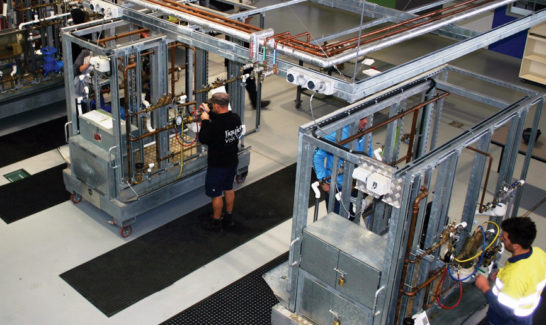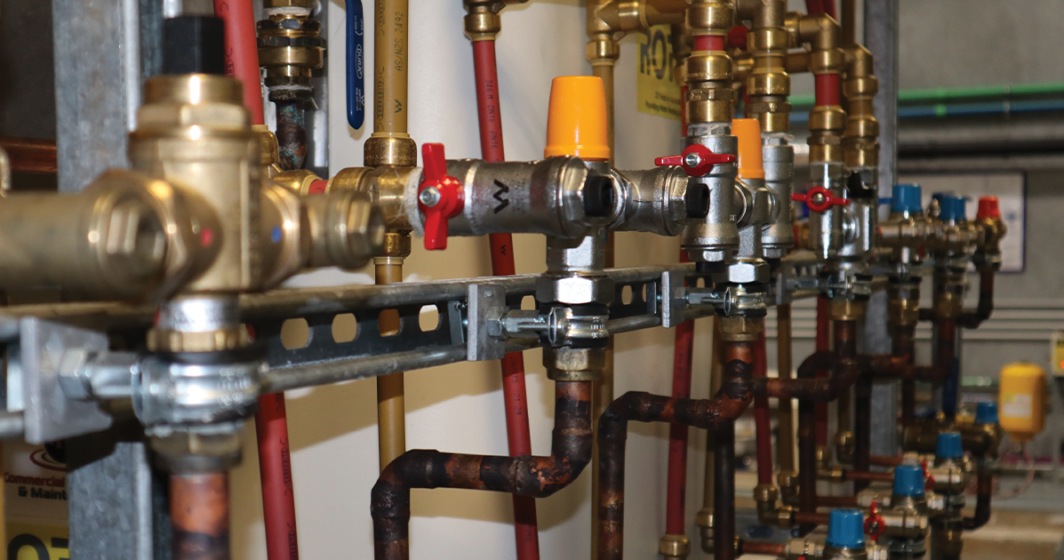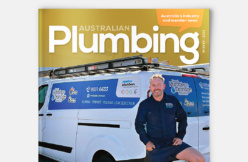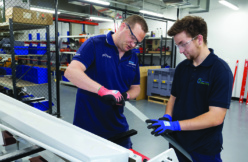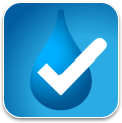One of the programs to be delivered at Narre Warren will be thermostatic mixing valve (TMV) maintenance training. November 2019 saw some significant changes to the way TMV licensing and registration was facilitated in Victoria so it was essential that anyone undertaking the training at Master Plumbers would be exposed to the broadest range of valves possible.
Enter Norm Anderson from Commercial Hot Water and Maintenance:
“I was contacted by Shayne LaCombre, Greg Tink and Brendan Gould who came to me to discuss a project similar to the (TMV) training rigs that we had previously built for the Brunswick PICAC campus. They wanted to ensure the quality of training required for plumbers due to the recent licensing changes,” Norm said.
“The original training environment for TMVs consisted of valves that were fixed in place directly to the wall in the Brunswick training centre, which added some complexities when it came time to swapping out superseded valves. The need to duplicate this setup at multiple locations was both a costly exercise for equipment and the need for a dedicated footprint.
“Even back then there was an emphasis on creating a mobile training plant to facilitate the portability of the training that they wanted to deliver.
“There are plumbers all across Victoria who need this training and we needed a solution that was light enough to be transported easily but sturdy enough to hold up to the rigors of a group of heavy-handed plumbers.”
Already having completed a version of this project provided a good base for work to commence, but Norm was keen to deliver a greater learning experience through a more efficient design and the installation of some new technology that enabled better serviceability.
“We took a lot of time to review the existing design and see where we could make inroads into delivering a more efficient solution,” Norm said.
“The first design idea incorporated two trolleys, one as a master and the other as a slave; meaning only one trolley was fitted with the controls and hot water storage, and this was the first thing to change. We decided to install a tank and controls on each rig so they could be used independently of each other, allowing them to be used apart in smaller areas and even in separate locations altogether if required.
“We constructed a lighter frame and mounted a uni-strut network around it to reduce the overall weight and through redesigning the layout I was able to get more valves on the trolleys, which further negated the reason for having a slave set-up, we were able to have two trolleys with up to 48 valves on each.”
Norm’s son, a first-year apprentice at Brunswick, worked as part of the plumbing team to build the rigs at Commercial Hot Water and Maintenance pre-fab factory on the Mornington Peninsula. The build took about 280 hours: 140 hours for each rig.
“This was truly built by plumbers for plumbers,” Norm said.
“It was a great project for them to be involved in. They’re very familiar with the internal tech used in mobile and plug and play rigs as it’s a product we build ourselves a lot and we also distribute them around Australia.”
Coincidentally, the ROTEX tank used in the project is the same as the ones used on the roof of the Narre Warren training centre that utilise solar photovoltaic (PV) technology to heat the water. Add this to the extremely efficient insulation properties of the ROTEX tank - losing only two degrees in temperature across a 24-hour idle period - and you have a very efficient system.
“The ROTEX tank is a 500 litre heat transfer tank that has a 316 stainless steel coil acting as a heat exchanger inside it, the potable water travels through this coil providing safe hygienic water for use,” Norm explained.
“There is a 14.4kw electric element inside the tank that heats the water up to 65 degrees, the water then passes around on a flow and return on the trolley that will go through the coil and back and around so it will continually keep the water hot. Cold water is also supplied within the pipework on the trolley to allow for the testing of each individual TMV.”
The end result is a pretty impressive piece of equipment that exposes as much of the internal working as possible to enhance the learning experience.
“One of the main things we wanted to achieve in completing this project was not only to have something that did the job, but created a learning tool that looked great exposing pipework that is normally hidden behind a wall.
“We were lucky enough to have some of the materials donated for the project, such as the two ROTEX tanks, various TMV’s and Sharkbite pipes and fittings. We wanted to showcase the different ways of plumbing the rigs, using both welded and pressed copper in the installations, including and incorporating as many industrial fixings so that it would be as familiar as possible to the students when they were to eventually encounter this setup on site.”
